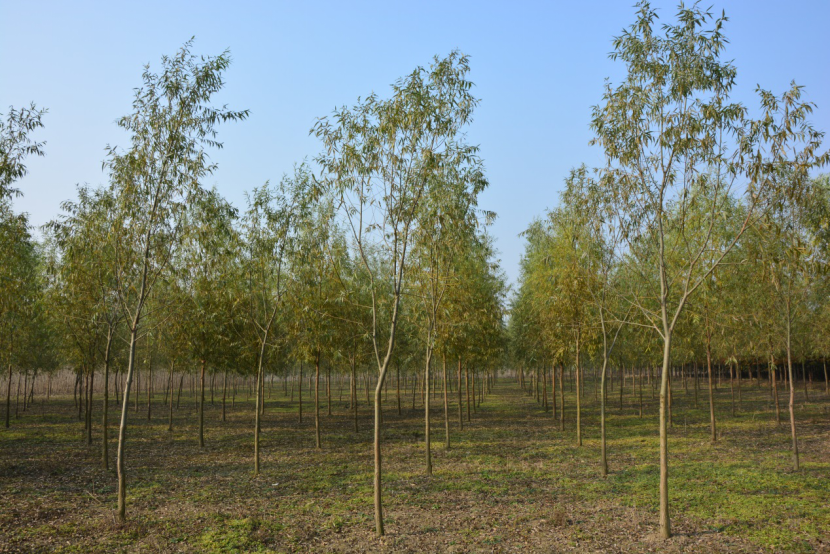 PDF(2649 KB)
PDF(2649 KB)


Construction of fingerprints for 33 varieties in Salicaceae
HE Xudong, ZHENG Jiwei, SUN Chong, HE Kaiyue, WANG Baosong
Journal of Nanjing Forestry University (Natural Sciences Edition) ›› 2021, Vol. 45 ›› Issue (2) : 35-42.
 PDF(2649 KB)
PDF(2649 KB)
 PDF(2649 KB)
PDF(2649 KB)
Construction of fingerprints for 33 varieties in Salicaceae
 ,
,

【Objective】Populus and Salix are members of Salicaceae family. They are dioecious catkin-bearing woody plants that propagate easily, grow fast, and serve as an important source of wood (for furniture), plywood, fiberboard, and pulp and paper industries. In recent years, numerous Populus and Salix varieties have been selected and widely used for afforestation. However, the morphological characteristics among the varieties of Populus and Salix are quite similar, making it difficult to popularize and protect them. To precisely identify different varieties of Salicaceae, a fingerprint for improved varieties of Populus and Salix was established in this study. 【Methods】A total of 38 pairs of expressed sequence tag-derived simple sequence repeat (EST-SSR) markers with high polymorphism information content (PIC) derived from Salix in a previous study were selected randomly to evaluate the transferability of 33 varieties of Salicaceae, of which 12 were genotyped using the fluorescence dUTP method. The fingerprint of different varieties was constructed by the combination of the core primers. To elucidate the genetic relationship between the different varieties, the unweighted pair group method arithmetic average (UPGMA) was used for clustering analysis. 【Result】Among the 38 EST-SSR markers, transferability was 68.4% and 57.89% across all the Populus and Salix varieties, respectively. After genotyping, a total of 97 alleles were detected by 12 pairs of EST-SSR markers, and the number of alleles per locus ranged from 5 to 13, with an average of 8.1 alleles. The PIC of the 12 loci varied from 0.637 2 to 0.834 8, with an average of 0.781 7. Among the three optimal pairs of core primers, the combination of SALeSSR0340 and SALeSSR0346 completely distinguish 12 Populus varieties, and the combination of SALeSSR0259, SALeSSR0340, and SALeSSR0346 completely identified all the 33 varieties used in our study. Cluster analysis demonstrated that the similarity coefficient for the 33 improved varieties ranged from 0.68 to 0.96, and all the improved varieties could be separated into two clades, namely, the genera Populus and Salix, which consisted of the traditional taxonomy of Salicaceae. The clustering result of the genetic relationship of each variety also corresponded with the genetic background. 【Conclusion】In this study, the fingerprints of 33 improved varieties of Salicaceae were constructed and their genetic relationships were evaluated. The divergences between varieties could be effectively screened by the EST-SSR markers, and the genotyping system established in this study was also accurate and efficient. These results can provide scientific evidence for the identification, protection, and popularization of improved varieties of Populus and Salix.

Populus spp. / Salix spp. / SSR marker / fingerprint / genetic relationship / genotyping
| [1] |
|
| [2] |
|
| [3] |
|
| [4] |
|
| [5] |
|
| [6] |
|
| [7] |
|
| [8] |
|
| [9] |
|
| [10] |
|
| [11] |
|
| [12] |
|
| [13] |
荣浩, 黄彬, 周琦, 等. 61个观赏海棠品种的SSR指纹图谱构建及遗传多样性分析[J]. 南京林业大学学报(自然科学版), 2018,42(3):45-50.
|
| [14] |
段一凡, 王贤荣, 梁丽丽, 等. 桂花品种SSR荧光指纹图谱的构建[J]. 南京林业大学学报(自然科学版), 2014,38(S1):1-6.
|
| [15] |
|
| [16] |
|
| [17] |
|
| [18] |
|
| [19] |
|
| [20] |
|
| [21] |
王源秀, 徐立安, 黄敏仁. 杞柳和簸箕柳候选杂交亲本SSR指纹分析[J]. 南京林业大学学报(自然科学版), 2008,32(2):1-5.
|
| [22] |
郑纪伟, 孙冲, 周洁, 等. 柳树DNA提取改良方法研究[J]. 江苏林业科技, 2014,41(6):4-6,58.
|
| [23] |
|
| [24] |
|
| [25] |
|
| [26] |
|
| [27] |
|
| [28] |
|
| [29] |
杨彦伶, 张亚东, 张新叶. 杨树SSR标记在柳树中的通用性分析[J]. 分子植物育种, 2008,6(6):1134-1138.
|
| [30] |
韩骞, 王辉, 王进茂, 等. 利用SSR引物通用性分析杨柳科树种遗传多样性[J]. 分子植物育种, 2009,7(5):904-911.
|
| [31] |
涂忠虞. 柳树育种与栽培[M]. 南京: 江苏科学技术出版社, 1982.
|
| [32] |
冯锦霞, 张川红, 郑勇奇, 等. 利用荧光SSR标记鉴别杨树品种[J]. 林业科学, 2011,47(6):167-174.
|
| [33] |
贾会霞, 姬慧娟, 胡建军, 等. 杨树新品种的SSR指纹图谱构建和倍性检测[J]. 林业科学, 2015,51(2):69-79.
|
| [34] |
郑纪伟, 教忠意, 窦全琴, 等. 利用荧光SSR标记构建含笑种质指纹图谱[J]. 分子植物育种, 2018,16(14):4705-4714.
|
| [35] |
贾会霞, 吴立栓, 胡建军, 等. 柳树种质资源遗传多样性和亲缘关系的CE-AFLP分析[J]. 林业科学, 2013,49(6):37-44.
|
/
| 〈 |
|
〉 |